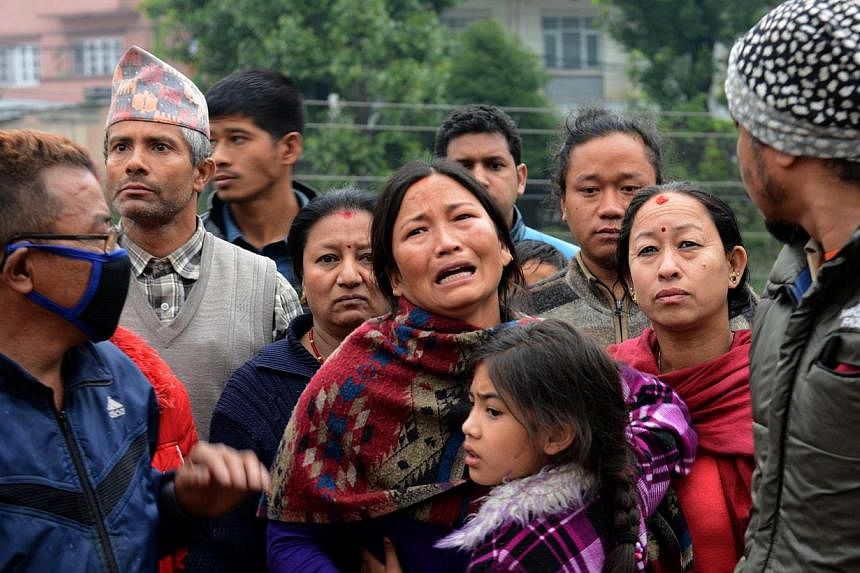KATHMANDU (REUTERS) - Hundreds of Nepalis were fleeing the capital Kathmandu for the plains on Monday, terror-stricken by two days of powerful aftershocks following a massive earthquake that killed more than 3,200 people and faced with shortages of food and water.
Roads leading out of the mountain valley city of one million were jammed with people, many with babies in their arms, trying to climb onto buses or hitch a ride aboard cars and trucks.
Many said they had slept in the open since Saturday's quake, either because their homes were flattened or they were terrified that the aftershocks would bring them crashing down.
"We are escaping," said Krishna Muktari, who runs a small grocery store in Kathmandu city. "How can you live here? I have got children, they can't be rushing out of the house all night."
Overwhelmed authorities were trying to cope with a shortage of drinking water and food, as well as the threat of disease.
The sick and wounded were lying out in the open in Kathmandu, unable to find beds in the devastated city's hospitals. Surgeons set up an operating theatre inside a tent in the grounds of Kathmandu Medical College.
"We are overwhelmed with rescue and assistance requests from all across the country," said Deepak Panda, a member of the country's disaster management.
High in the Himalayas, hundreds of foreign and Nepali climbers remained trapped after a huge avalanche ripped through the Mount Everest base camp, killing 17 people in the single worst disaster to hit the world's highest mountain.
Across Kathmandu and beyond, exhausted families laid mattresses out on streets and erected tents to shelter from rain. People queued for water dispensed from the back of trucks, while the few stores still open had next to nothing on their shelves. Crowds jostled for medicine at one pharmacy.
A total of 3,218 people were confirmed killed in the 7.9 magnitude quake, a police official said on Monday, the worst in Nepal since 1934 when 8,500 died. More than 6,500 were injured.
Another 66 were killed across the border in India and at least another 20 in Tibet, China's state news agency said.
The toll is likely to rise as rescuers struggle to reach remote regions in the impoverished, mountainous country of 28 million people and as bodies buried under rubble are recovered.
- Little sign of aid -
With so many people sleeping in the open with no power or water and downpours forecast, fears mounted of major food and water shortages. Across Nepal, hundreds of villages have been left to fend for themselves.
"There is no electricity, no water. Our main challenge and priority is to restore electricity and water," said home ministry official Laxmi Prasad Dhakal. "The next big challenge is the supply of food. Shopkeepers are unable to go in and open their shops. So people are facing difficulty buying food."
Several countries rushed to send aid and personnel.
India flew in medical supplies and members of its National Disaster Response Force. China sent a 60-strong emergency team. Pakistan's army said it was sending four C-130 aircraft with a 30-bed hospital, search and rescue teams and relief supplies.
A Pentagon spokesman said a US military aircraft with 70 personnel left the United States on Sunday and was due in Kathmandu on Monday. Australia, Britain and New Zealand said they were sending specialist urban search-and-rescue teams to Kathmandu at Nepal's request.
Britain, which believes several hundred of its nationals are in Nepal, was also delivering supplies and medics.
However, there has been little sign of international assistance on the ground so far, with some aid flights prevented from landing by aftershocks that closed Kathmandu's main airport several times on Sunday.
In the Himalayas, hundreds of climbers felt tremors on Sunday powerful enough to send snow and boulders cascading towards them. Another was felt early on Monday.
The huge and deadly avalanche on Saturday triggered by the earthquake caused panic at the Everest base camp, a sprawling"city" of tents from where mountaineers set off for the world's highest peak.
"It was a monstrous sound, like the demons had descended on the mountain," Khile Sherpa, a Nepali guide, told Reuters, recalling the moment the avalanche hit.
He was one of the few airlifted to the relative safety of Kathmandu but the disaster has underlined the woeful state of Nepal's medical facilities.
Nepal has only 2.1 physicians and 50 hospital beds for every 10,000 people, according to a 2011 World Health Organisation report.
At the Tribhuvan University Teaching Hospital, bodies, including that of a boy aged about seven, were heaped in a dark room. The stench was overpowering.
Rajiv Biswas, Asia Pacific chief economist at business research firm IHS, said long-term reconstruction costs in Nepal using proper building standards for an earthquake zone could be more than US$5 billion (S$6.6 billion), or around 20 per cent of the country's GDP.
"With housing construction standards in Nepal being extremely low ... the impact of the earthquake has been devastating based on initial reports," he said in an early analysis of the likely damage.

